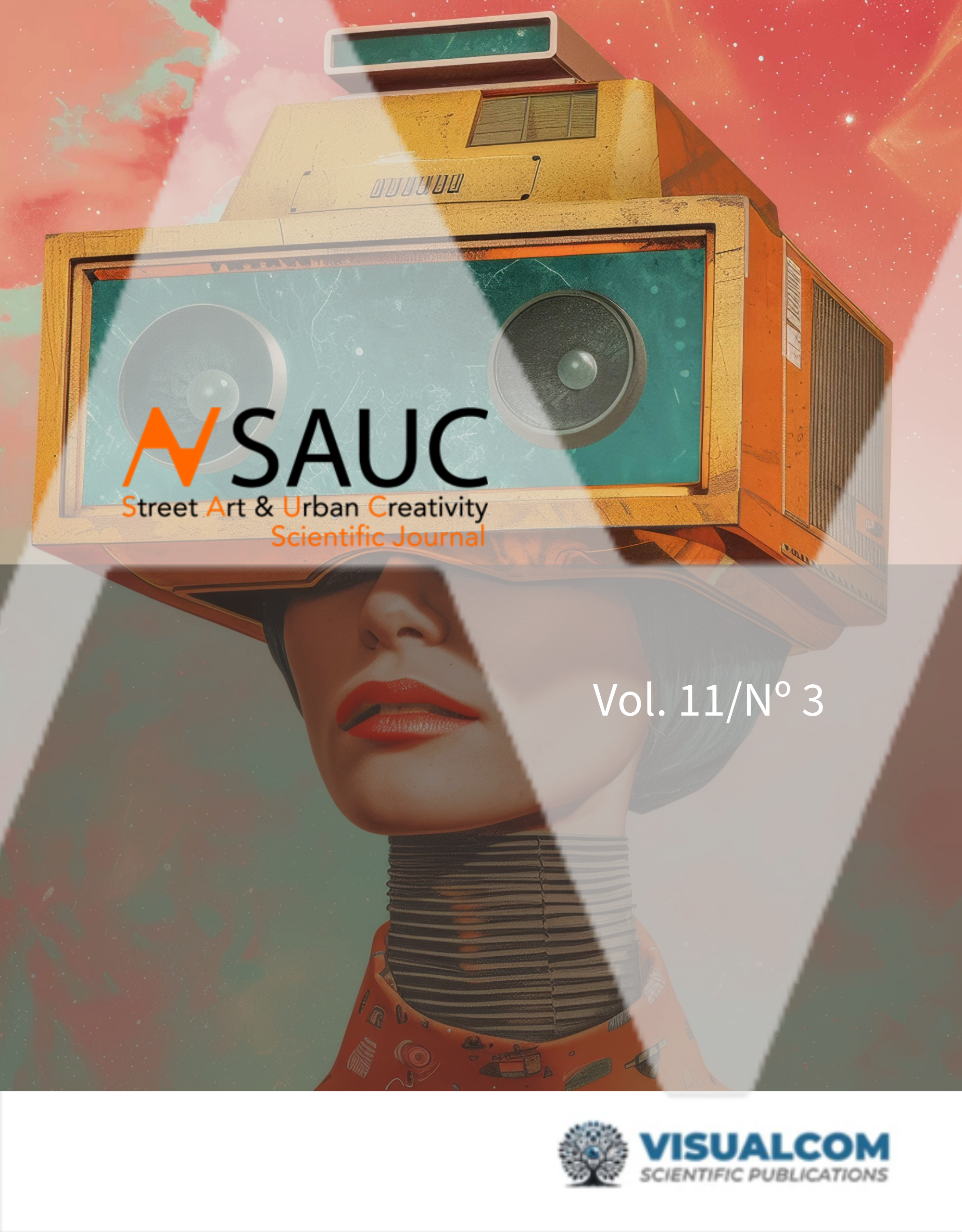Data-Driven Self-Portraits
Intimate connections with urban information
DOI:
https://doi.org/10.62161/sauc.v11.5724Keywords:
Autoethnography, Data-driven self-portraits, Critical cartography, Data visualization, Trajectories, Urban cyclists, PerformanceAbstract
A set of data-driven sculptures has been implemented in the city of Quito. These interventions visualize the movement of urban cyclists. To create them, a series of interfaces were designed to record and present their movement.
This article explores the author’s personal connection with Quito by creating personalized maps that trace their most significant cycling routes. During this process, the author reflects on the tension between objectivity and subjectivity in urban research. By employing an autoethnographic methodology and using data-driven self-portraits, a more intimate relationship with the data is promoted, encouraging more humanized and diverse interpretations.
This approach contributes to building a more pluralistic vision of the city, distancing itself from colonial perspectives. This proposal adds to the debate on creative cities, highlighting the need for new formats of representations to study the multiple forms of connectivity in the city.
Downloads
Global Statistics ℹ️
|
333
Views
|
212
Downloads
|
|
545
Total
|
|
References
Barriga-Abril, X., Vivanco, J., Rosas, C., Medina, X., Aulestia, A., & Basantes, A. (2024). Making the Invisible Visible: revealing data in the city. Proceedings of International Structural Engineering and Construction, 11(1), 2024. https://doi.org/10.14455/ISEC.2024.11(1).AAE-04 DOI: https://doi.org/10.14455/ISEC.2024.11(1).AAE-04
Benford, S., Giannachi, G., Koleva, B., & Rodden, T. (2009). From interaction to trajectories: designing coherent journeys through user experiences. Proceedings of the SIGCHI Conference on Human Factors in Computing Systems (CHI '09) (pp. 709–718). Association for Computing Machinery. https://doi.org/10.1145/1518701.1518812 DOI: https://doi.org/10.1145/1518701.1518812
Camfield, W. A. (1979). Marcel Duchamp’s Fountain: Its History and Aesthetics in the Context of 1917. Dada/Surrealism, 10, 64-94.
Carrión, F., & Erazo Espinosa, J. (2012). La forma urbana de Quito: una historia de centros y periferias. Bulletin de l’Institut Français d’Études Andines, 41(3), 503-522. https://doi.org/10.4000/bifea.361 DOI: https://doi.org/10.4000/bifea.361
Ciclopolis. (2016). CICLOPASEO. https://ciclopolisecuador.wixsite.com/ciclopolis/ciclopaseo-quito
Ciuccarelli, P., Lupi, L., & Simeone, L. (2014). Visualizing the Data City: Social Media as a Source of Knowledge for Urban Planning and Management. Springer. DOI: https://doi.org/10.1007/978-3-319-02195-9
Crampton, J., & Krygier, J. (2010). An Introduction to Critical Cartography. ACME: An International E-Journal for Critical Geographies, 4. https://doi.org/10.14288/acme.v4i1.723
Dalton, C., & Thatcher, J. (2015). Inflated granularity: Spatial "Big Data" and geodemographics. Big Data & Society, 2. https://doi.org/10.1177/2053951715601144 DOI: https://doi.org/10.1177/2053951715601144
Debord, G. (1956). Théorie de la dérive. Internationale Situationniste, (2), 62-66.
Donath, J. S., Dragulescu, A., Zinman, A., Viégas, F. B., & Xiong, R. (2010). Data Portraits. Leonardo, 43, 375-383. https://doi.org/10.1145/1836786.1836793 DOI: https://doi.org/10.1162/LEON_a_00011
Ellegård, K., & Svedin, U. (2012). Torsten Hägerstrand’s time-geography as the cradle of the activity approach in transport geography. Journal of Transport Geography, 23, 17-25. https://doi.org/10.1016/j.jtrangeo.2012.03.023 DOI: https://doi.org/10.1016/j.jtrangeo.2012.03.023
Ellis, C. (2004). The ethnographic I: A methodological novel about autoethnography. AltaMira Press.
Google Maps (2016). Ciclovías de Quito https://www.google.com/maps/d/u/0/viewer?hl=es-419&gl=ec&ptab=2&ie=UTF8&oe=UTF8&msa=0&mid=1MEELI1AwPodqn_NuXIOT6023UAU&ll=-0.20441961313110335%2C-78.4692087085404&z=13
Golledge, R. G. (1999). Wayfinding Behavior: Cognitive Mapping and Other Spatial Processes. Johns Hopkins University Press.
Harley, J. B. (2001). The New Nature of Maps: Essays in the History of Cartography. Johns Hopkins University Press.
Lefebvre, H. (1991). The production of space (D. Nicholson-Smith, Trans.). Blackwell. (Original work published 1974).
LeWitt, S. (1969). Sentencias sobre el arte conceptual. Art and Artists, 1(4), 75-83.
Lo Presti, L. (2018). Extroverting Cartography. "Seensing" Maps and Data Through Art. Journal of Research and Didactics in Geography (J-READING), 2(7), 119-134
Lynch, K. (1960). The image of the city. MIT Press.
Manovich, L. (2010). Info-Aesthetics. Bloomsbury Academic.
Montello, D. R. (2005). Navigation. En P. Shah, & A. Miyake (Eds.), The Cambridge Handbook of Visuospatial Thinking (pp. 257-294). Cambridge University Press. https://psycnet.apa.org/doi/10.1017/CBO9780511610448.008 DOI: https://doi.org/10.1017/CBO9780511610448.008
Pearson, M., & Thomas, J. (1994). Theatre/Archaeology. TDR (1988-), 38(4), 133–161. https://doi.org/10.2307/1146429 DOI: https://doi.org/10.2307/1146429
Pelias, R. (2004). A Methodology of the Heart: Evoking Academic and Daily Life. Rowman & Littlefield. DOI: https://doi.org/10.5771/9780759115576
Peluso, N. L. (1995). Whose woods are these? Counter-mapping forest territories in Kalimantan, Indonesia. Antipode, 27(4), 383-406. https://doi.org/10.1111/j.1467-8330.1995.tb00286.x DOI: https://doi.org/10.1111/j.1467-8330.1995.tb00286.x
Picon, A., & Ratti, C. (2023). Atlas of the Sensable City. Yale University Press. https://doi.org/10.12987/9780300271737 DOI: https://doi.org/10.12987/9780300271737
Pink, S. (2001). Doing Visual Ethnography. Sage Publications.
Quito Cómo Vamos. (2020). Informe de Calidad de Vida. https://quitocomovamos.org/wp-content/uploads/2021/06/INFORME-DE-CALIDAD-DE-VIDA-QUITO-COMO-VAMOS-pliego2.pdf
Rossetto, T., & Lo Presti, L. (2022). Reimagining the national map. Dialogues in Human Geography, 12(1), 5-27. https://doi.org/10.1177/20438206211017440 DOI: https://doi.org/10.1177/20438206211017440
Sauter, D. (2010). Ketai Library. https://www.danielsauter.com/display.php?project_id=113
Schwarze, T. (2023). Henri Lefebvre and the Production of Space. In Space, Urban Politics, and Everyday Life. Palgrave Macmillan. https://doi.org/10.1007/978-3-031-46038-8_2 DOI: https://doi.org/10.1007/978-3-031-46038-8
Spry, T. (2001). Performing Autoethnography: An Embodied Methodological Praxis. Qualitative Inquiry, 7(6), 706-732. https://doi.org/10.1177/10778004010070 DOI: https://doi.org/10.1177/107780040100700605
Downloads
Published
How to Cite
Issue
Section
License
Copyright (c) 2025 Authors retain copyright and transfer to the journal the right of first publication and publishing rights

This work is licensed under a Creative Commons Attribution-NoDerivatives 4.0 International License.
Those authors who publish in this journal accept the following terms:
-
Authors retain copyright.
-
Authors transfer to the journal the right of first publication. The journal also owns the publishing rights.
-
All published contents are governed by an Attribution-NoDerivatives 4.0 International License.
Access the informative version and legal text of the license. By virtue of this, third parties are allowed to use what is published as long as they mention the authorship of the work and the first publication in this journal. If you transform the material, you may not distribute the modified work. -
Authors may make other independent and additional contractual arrangements for non-exclusive distribution of the version of the article published in this journal (e.g., inclusion in an institutional repository or publication in a book) as long as they clearly indicate that the work was first published in this journal.
- Authors are allowed and recommended to publish their work on the Internet (for example on institutional and personal websites), following the publication of, and referencing the journal, as this could lead to constructive exchanges and a more extensive and quick circulation of published works (see The Effect of Open Access).













